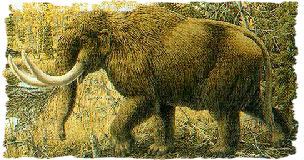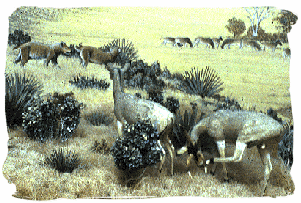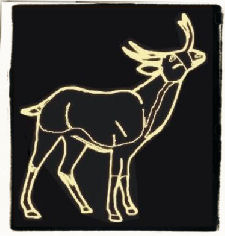The Kailiauk
Tri-Horned Ruminants
An Important Ruminant to the Savages
The kaiiliauk is a large, very dangerous, migratory ruminant beast, tawny with red and brown markings on haunches, and trident-horned. The average male stands approximately ten (10) hands at the shoulder, weighing approximately 400 to 500 Gorean stone (1600 to 2000 pounds); the average female stands approximately eight (8) hands, weighing approximately 300 to 400 Gorean stone (1200 to 1600 pounds). Ruminant refers to a cud-chewing hoofed mammal, such as cattle, bison, sheep, goats, antelopes, deer, chevrotains, rhinoceros, giraffes, llamas and camels.
The kaiiliauk is hunted generally on kaiilaback, it is hunted only on foot when in deep snow, as it almost helpless then. This beast is important to the red savages of the Barrens, the major source for food and life. Its meat, bones, horns, hide, and sinew provide food, shelter, clothing, tools and weapons. Many cultures consider the horns of the kailiauk to hold powerful healing magics. As these are herd beasts, often they are named for identification; three such herds are known as the Boswell herd, the Bento herd, and the Hogarthe herd, named after the first white men who saw them and numbered them. It is estimated that each herd has approximately two to three million beasts. Gor must an awfully large planet and the Barrens themselves must span for thousands of miles!
"Even past me there thundered a lumbering herd of startled, short-bunked kailiauk, a stocky, awkward ruminant of the plains, tawny, wild, heavy, their haunches marked in red and brown bars, their wide heads bristling with a trident of horns; they had not stood and formed their circle, she's and young within the circle of tridents; they, too, had fled…" — Nomads of Gor, page 2.
"Kailiauk are four-legged, wide-headed, lumbering, stocky ruminants. Their herds are usually found in the savannahs and plains north and south of the rain forests, but some herds frequent the forests as well. These animals are short-trunked and tawny. They commonly have brown and reddish bars on the haunches. The males, tridentlike, have three horns. These horns bristle from their foreheads. The males are usually about ten hands at the shoulders and the females about eight hands. The males average about four hundred to five hundred Gorean stone in weight, some sixteen hundred to two thousand pounds, and the females average about three to four hundred Gorean stone in weight, some twelve hundred to sixteen hundred pounds." — Explorers of Gor, page 93.
Famous Herds
The herds of kailiauk which call the barrens their home are often identified by the human residents by naming them after a particular event, such as the Boswell herd, the Bento herd and the Hogarthe herd, all named after the first white men to see them. These herds number somewhere between two- to three-million beasts. Smaller herds number only in the hundreds of thousands. The herds migrate as well. As the math is played out in my head, that's one very large mass of land known as the Barrens!
"The Barrens are traversed by a large number of herds. The four or five best-known herds, such as the Boswell herd, he for whom the Boswell Pass is named, and the Bento herd and the Hogarthe herd, named after the first white men who saw them, number, it is estimated, between two and three million beasts. The tremors in the earth from such a herd can be felt fifty pasangs away. It takes such a herd two to three days to ford a river. It has occasionally happened that enemy tribes have preyed on such a herd at different points and only afterwards, to their chagrin and amusement, realized their proximity to one another. Besides these major herds there are several smaller, identifiable herds numbering in the hundreds of thousands of animals. Beyond these, as would be expected, are many smaller herds, the very numbers of which are not even calculated by the red savages themselves, herds often range from a few hundred to several thousand animals. It is speculated that some of these smaller herds may be subherds of larger herds, separating from the major herd at certain points during the season, depending on such conditions as forage and water. If that is the case then the number of kailiauk may not be quite as large as it is sometimes estimated. On the other hand, that their numbers are incredibly abundant is indubitable. These herds, too, interestingly enough, appear to have their annual grazing patterns, usually describing a gigantic oval, seasonally influenced, which covers many thousands of pasangs. These peregrinations, as would be expected, tend to take a herd in and out of the territory of given tribes at given times. The same herd, thus, may be hunted by various tribes without necessitating dangerous departures from their own countries. The kailiauk is a migratory beast, thusly, but only in a rather special sense. It does not, for example, like, certain flocks of birds, venture annually in roughly linear paths from the north to the south, and from the south to the north, covering thousands of pasangs in a series of orthogonal alternations. The kailiauk must feed as it moves, and it is simply too slow for this type of migration. It could not cover the distances involved in the times that would be necessary. Accordingly the herds tend not so much to migrate with the seasons as to drift with them, the ovoid grazing patterns tending to bend northward in the summer and southward in the winter. The smell of the hide sheds, incidentally, gives a very special aroma to the atmosphere of Kailiauk. After one has been there for a few hours, however, the odor of the hides, now familiar and pervasive, tends to be dismissed from consciousness." — Savages of Gor, pages 94-95.
Conjecture
By description of the kailiauk, there is debate as to exactly what sort of beast it was. Mastodon? Tricerotops? The figment of John Norman's imagination? The possibilities are endless, but upon some research, I came up with some possibilities of what the kailiauk might possibly be, or at least, started to be. The word "ruminant" refers to a cud-chewing hoofed mammal, such as cattle, bison, sheep, goats, antelopes, deer, chevrotains, elephant, rhinoceros, giraffes, llamas and camels. The tricerotops is immediately disregarded, as the kailiauk is a mammal, not reptile. Let's explore the earlier relatives of the modern-day ruminant.
 The genus Mastodon, (from Greek Mastos, meaning breast, and odon: tooth, referring to the the nipple-shaped protrusions on the crowns of its molars) belongs to the family Mammutidae, which is a family within the mammal order Proboscidea (this includes tapers). Although Mastodons share their ancestor, Palaeomastodon, with the elephants they remain a side line of their own, and has less relation with the recent elephants, and the Mammoths. Seven million years ago the Mastodons spread to north America, and later to south America. The mastodons were about the same size as the elephants and the mammoths, but more muscled, and most species had fur. The upper jaw had two big tusks, the lower jaw had two smaller tusks. Mastodons had never more than two molars in the jaw at the same time. Although a ruminant, this mammal was not horned. It's very likely that the Mastodon was not the prototype for the kailiauk.
The genus Mastodon, (from Greek Mastos, meaning breast, and odon: tooth, referring to the the nipple-shaped protrusions on the crowns of its molars) belongs to the family Mammutidae, which is a family within the mammal order Proboscidea (this includes tapers). Although Mastodons share their ancestor, Palaeomastodon, with the elephants they remain a side line of their own, and has less relation with the recent elephants, and the Mammoths. Seven million years ago the Mastodons spread to north America, and later to south America. The mastodons were about the same size as the elephants and the mammoths, but more muscled, and most species had fur. The upper jaw had two big tusks, the lower jaw had two smaller tusks. Mastodons had never more than two molars in the jaw at the same time. Although a ruminant, this mammal was not horned. It's very likely that the Mastodon was not the prototype for the kailiauk.

The Cranioceras was a three-horned ruminant found in during Miocene Epoch (meaning "moderately recent"), which extends from approximately 23 million years ago until 5 million years ago. The Cranioceras, an ancestor of the deer, is comparatively small in relation to the kailiauk. This picture shows the contrast of the Cranioceras and the Hemicyon, or "bear-dog," which stood only 28 inches tall. This tri-horned ruminant would be a relative of the tabuk of Gor, but not the kailiauk.
 The Protoceras was a tri-horned ruminant of the late Oligocene period, and occupied the hills and mountains of western South Dakota. Paleontologists have found battered scraps of its skeletons in the White River Badlands where perhaps they were washed by heavy spring rains running off the hills to the west. The Protoceras had six bony bumps on its head that presumably bore short horns; one pair was over the nose, and another pair was over the eyes; the third was near the back of the skull. The Proteceras was the predecessor for the modern day moose. It's could very likely be that the Proteceras is Gor's kailiauk.
The Protoceras was a tri-horned ruminant of the late Oligocene period, and occupied the hills and mountains of western South Dakota. Paleontologists have found battered scraps of its skeletons in the White River Badlands where perhaps they were washed by heavy spring rains running off the hills to the west. The Protoceras had six bony bumps on its head that presumably bore short horns; one pair was over the nose, and another pair was over the eyes; the third was near the back of the skull. The Proteceras was the predecessor for the modern day moose. It's could very likely be that the Proteceras is Gor's kailiauk.
It's possible too, that the kailiauk was native to Gor or a planetary system far from Earth brought to Gor by the Priest-Kings.
Take a trip on my Time Machine and visit the beasts that lived millions of years ago on Earth, The visit is free of course. Please take a peek at the "Blast to the Past" page.
![]()
Special Note
Because of the differences in publishing the books, depending upon whether published in the U.S. or Europe, depending upon whether a first publishing or a Masquerade Books release, page numbers will often vary. All of my quotes are from original, first-printing U.S. publications (see The Books page for a listing of publishers and dates) with the exception of the following books:
- Tarnsman of Gor (2nd Printing, Balantine)
- Outlaw of Gor (11th Printing, Balantine)
- Priest-Kings of Gor (2nd Printing, Balantine)
- Assassin of Gor (10th Printing, Balantine)
- Raiders of Gor (15th Printing, Balantine)
- Captive of Gor (3rd Printing, Balantine)
Disclaimer
These pages are not written for any specific home, but rather as informational pages for those not able to get ahold of the books and read them yourself. Opinions and commentaries are strictly my own personal views, therefore, if you don't like what you are reading — then don't. The information in these pages is realistic to what is found within the books. Many sites have added information, assuming the existences of certain products and practices, such as willowbark and agrimony for healing, and travel to earth and back for the collection of goods. I've explored the books, the flora, the fauna, and the beasts, and have compiled from those mentioned, the probabilities of certain practices, and what vegetation mentioned in the books is suitable for healing purposes, as well as given practicalities to other sorts of roleplaying assumptions.